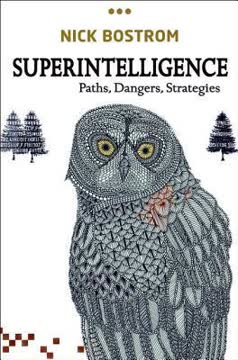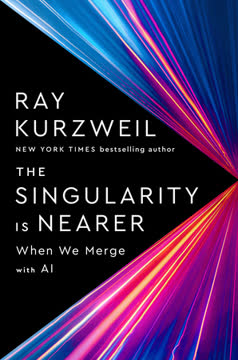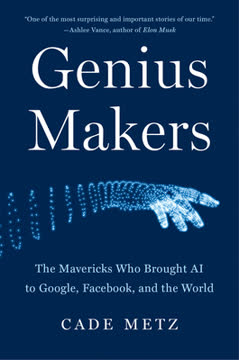Key Takeaways
1. Abundance is possible: Exponential technologies are transforming scarcity into plenty
"Providing abundance is humanity's grandest challenge—this is how we rise to meet it."
Exponential growth. Technologies in fields like computing, biotechnology, and nanotechnology are advancing at an exponential rate, doubling in power and halving in cost every 12-24 months. This rapid progress is enabling solutions to global challenges that were once thought impossible.
Dematerialization and demonetization. As technologies improve, they often become smaller, cheaper, and more accessible. For example, a modern smartphone replaces dozens of previously separate devices, from cameras to GPS units to music players. This trend is making powerful tools available to more people at lower costs.
Abundance pyramid. The book outlines a hierarchy of human needs, from basic necessities like water and food to higher-level goals like education and freedom. Exponential technologies are providing solutions at each level of this pyramid, paving the way for a world of abundance for all.
2. The psychology of abundance: Overcoming cognitive biases and pessimism
"Our brains are wired to focus on the negative, but this instinct can blind us to the incredible progress happening all around us."
Negativity bias. Our brains evolved to prioritize threats and negative information, which can lead us to overestimate dangers and underestimate positive developments. This bias is amplified by modern media, which tends to focus on crises and problems.
Cognitive distortions. Several mental shortcuts and biases can prevent us from accurately assessing progress:
- Availability heuristic: We overestimate the likelihood of events that are easy to recall
- Anchoring: We rely too heavily on the first piece of information we encounter
- Confirmation bias: We seek out information that confirms our existing beliefs
Shifting perspective. To overcome these biases, we need to:
- Seek out positive news and long-term trend data
- Practice gratitude and acknowledge progress
- Cultivate optimism while remaining realistic about challenges
3. Building the foundation: Water, food, and energy solutions for a growing population
"We are now living in a world of information and communication abundance."
Water solutions. Innovations addressing water scarcity include:
- Dean Kamen's Slingshot water purifier
- Nanotechnology-based filtration systems
- Smart grids for efficient water management
Food revolution. Advances in agriculture and food production:
- Vertical farming and urban agriculture
- Genetically engineered crops for increased yield and nutrition
- Lab-grown meat and alternative proteins
Clean energy breakthroughs. Progress in renewable energy:
- Solar power: Rapidly declining costs and increasing efficiency
- Advanced nuclear: Safer, cleaner designs like thorium reactors
- Energy storage: Improved batteries and grid-level solutions
These technologies are making it possible to provide basic necessities to a growing global population while reducing environmental impact.
4. Revolutionizing healthcare: AI, robotics, and personalized medicine
"We are entering a period of explosive transformation in which technology has the potential to significantly raise the basic standards of living for every man, woman, and child on the planet."
AI-powered diagnostics. Systems like IBM's Watson are being trained to analyze medical data and assist in diagnosis, potentially outperforming human doctors in certain areas.
Robotic surgery. Advances in surgical robotics, like the da Vinci system, are enabling more precise and less invasive procedures.
Personalized medicine. Breakthroughs in genomics and data analysis are allowing for tailored treatments based on an individual's genetic makeup and health history.
Additional healthcare innovations:
- 3D-printed organs and prosthetics
- Nanomedicine for targeted drug delivery
- Telemedicine and remote patient monitoring
These technologies have the potential to dramatically improve healthcare outcomes while reducing costs and increasing access.
5. Reimagining education: Gamification, online learning, and personalized instruction
"Imagine a world of nine billion people with clean water, nutritious food, affordable housing, personalized education, top-tier medical care, and nonpolluting, ubiquitous energy."
Online learning platforms. Initiatives like Khan Academy and Coursera are making high-quality education accessible to anyone with an internet connection.
Gamification. Educational games and simulations are making learning more engaging and effective, especially for younger students.
AI-powered personalization. Adaptive learning systems can tailor instruction to each student's individual needs, pace, and learning style.
Key trends in education technology:
- Virtual and augmented reality for immersive learning experiences
- Peer-to-peer learning networks
- Microlearning and bite-sized content delivery
- Lifelong learning and reskilling platforms for adults
These innovations are democratizing access to education and preparing students for a rapidly changing job market.
6. The power of DIY innovation: Small groups solving big problems
"Never doubt that a small group of thoughtful, committed citizens can change the world. Indeed, it is the only thing that ever has."
Maker movement. The rise of affordable 3D printing, open-source hardware, and collaborative online communities is enabling individuals to prototype and manufacture products that once required large companies.
Citizen science. Platforms like Zooniverse allow non-experts to contribute to scientific research, accelerating discoveries in fields from astronomy to biology.
Crowdsourcing solutions. Websites like InnoCentive connect organizations with a global network of problem solvers, tapping into diverse expertise to address complex challenges.
Examples of DIY innovation impact:
- Low-cost prosthetics designed by volunteers
- Open-source software powering critical infrastructure
- Crowdfunded renewable energy projects in developing countries
This democratization of innovation is allowing small groups to tackle problems once thought solvable only by governments or large corporations.
7. Technophilanthropy: Leveraging wealth and technology for global impact
"Today's technophilanthropists are a different breed. While the industrial revolution focused philanthropy locally, the high-tech revolution inverted the equation."
Strategic giving. Tech billionaires like Bill Gates and Mark Zuckerberg are applying business principles to philanthropy, focusing on measurable outcomes and scalable solutions.
Catalytic funding. Technophilanthropists often provide seed funding for innovative projects, attracting additional investment and spurring further innovation.
Technology-driven solutions. Many tech philanthropists focus on leveraging technology to address global challenges, such as:
- Using AI for medical research
- Developing clean energy technologies
- Improving education through digital platforms
This new approach to philanthropy is accelerating progress on critical issues and inspiring a new generation of socially-conscious entrepreneurs.
8. The rising billion: Empowering the world's poorest through connectivity
"For the first time ever, the rising billion will have the remarkable power to identify, solve, and implement their own abundance solutions."
Mobile revolution. The rapid spread of affordable smartphones is connecting billions of people to the global economy and information network.
Financial inclusion. Mobile banking and microfinance platforms are providing access to financial services for previously unbanked populations.
Digital education. Online learning resources are enabling people in remote areas to access world-class educational content.
Impacts of increased connectivity:
- Improved healthcare through telemedicine
- New economic opportunities through digital marketplaces
- Enhanced political participation and transparency
By bringing the world's poorest online, we're unlocking vast human potential and creating new markets for innovation.
9. Steering innovation: Incentive prizes and embracing failure
"The best way to predict the future is to create it yourself."
Incentive prizes. Competitions like the X PRIZE are spurring innovation by offering large rewards for achieving specific technological goals.
Rapid prototyping. Advances in 3D printing and simulation tools allow for faster, cheaper iteration on new ideas.
Embracing failure. A culture that celebrates "failing forward" and learning from mistakes is crucial for breakthrough innovation.
Strategies for accelerating innovation:
- Cross-disciplinary collaboration
- Open innovation platforms
- Regulatory sandboxes for testing new technologies
By creating the right incentives and environment for innovation, we can accelerate progress on critical global challenges.
10. The future of work: Adapting to AI and automation
"Exponential technologies may eventually permit people to not need jobs to have a high standard of living."
Job displacement. Automation and AI will likely eliminate many current jobs, particularly in manufacturing and routine cognitive tasks.
New opportunities. At the same time, new industries and job categories will emerge, often requiring higher-level skills and creativity.
Universal basic income. As automation increases productivity, some propose providing a basic income to all citizens to ensure a minimum standard of living.
Preparing for the future of work:
- Emphasizing creativity, emotional intelligence, and adaptability in education
- Lifelong learning and regular reskilling
- Exploring new economic models that don't rely solely on traditional employment
While the transition may be challenging, the long-term potential is for technology to free humans from drudgery and enable more fulfilling pursuits.
Last updated:
FAQ
What's Abundance: The Future Is Better Than You Think about?
- Focus on Abundance: The book explores how technological advancements can lead to a future of abundance, addressing global challenges like water, food, energy, and healthcare.
- Four Emerging Forces: Diamandis and Kotler identify four forces—exponential technologies, DIY innovators, technophilanthropists, and the rising billion—that are converging to solve humanity's grand challenges.
- Optimism in Innovation: The authors argue that we are on the brink of achieving more in the next two decades than in the last two hundred years, thanks to innovations in various fields.
Why should I read Abundance: The Future Is Better Than You Think?
- Inspiring Perspective: The book offers a hopeful outlook in contrast to the prevalent pessimism about global issues, showcasing real-world examples of innovation and progress.
- Understanding Technology's Role: It provides insights into how emerging technologies can be harnessed to improve living standards and tackle pressing global problems.
- Empowerment through Knowledge: Readers will gain knowledge about the potential of human ingenuity and the importance of collaboration in creating a better future.
What are the key takeaways of Abundance: The Future Is Better Than You Think?
- Technological Progress is Accelerating: Advancements in fields like AI, robotics, and biotechnology are growing exponentially, enabling solutions to previously insurmountable problems.
- Collaboration is Essential: The book highlights the importance of cooperation among individuals, organizations, and nations to leverage technology for the greater good.
- Abundance is Achievable: With the right mindset and tools, it is possible to meet the basic needs of every person on the planet.
What are the best quotes from Abundance: The Future Is Better Than You Think and what do they mean?
- “Abundance is a powerful antidote to today’s malaise and pessimism.”: This underscores the book's central theme that focusing on solutions and innovations can counteract negativity surrounding global challenges.
- “Technology is a resource-liberating mechanism.”: This emphasizes that technological advancements can transform scarce resources into abundant ones, changing our perception of availability.
- “When seen through the lens of technology, few resources are truly scarce; they’re mainly inaccessible.”: This highlights the idea that with innovation, we can unlock resources that currently seem limited.
How does Abundance: The Future Is Better Than You Think define "abundance"?
- Basic Needs Met: Abundance is described as a state where all individuals have access to essential resources like clean water, nutritious food, and healthcare.
- Possibility for Growth: It emphasizes creating a world where everyone can pursue their potential, not just survive, thus fostering creativity and innovation.
- Not Luxury, but Access: The authors clarify that abundance is not about providing luxury items but ensuring that everyone has the means to live a fulfilling life.
What role does technology play in achieving abundance according to Abundance: The Future Is Better Than You Think?
- Liberating Resources: Technology is portrayed as a means to unlock and make accessible resources that are currently scarce or difficult to obtain.
- Driving Innovation: Technological advancements can lead to breakthroughs that significantly improve quality of life and solve pressing global issues.
- Facilitating Collaboration: Technology enables better communication and cooperation among individuals and organizations, amplifying efforts to create solutions.
What are the four emerging forces discussed in Abundance: The Future Is Better Than You Think?
- Exponential Technologies: These are rapidly advancing fields such as AI, robotics, and biotechnology that have the potential to solve major global issues.
- DIY Innovators: Individuals and small groups who leverage technology and creativity to develop solutions, often outside traditional corporate or governmental structures.
- Technophilanthropists: Wealthy individuals who use their resources to fund innovative projects aimed at addressing global challenges.
- The Rising Billion: The growing population in developing countries that is gaining access to technology and education, enabling them to contribute to global solutions.
How does Abundance: The Future Is Better Than You Think address the issue of population growth?
- Population and Resources: Improving access to clean water and healthcare can lead to lower birth rates, as healthier populations tend to have fewer children.
- Empowering Women: By providing education and resources, particularly to women, communities can make informed choices about family planning and health.
- Sustainable Solutions: Technological innovations can help meet the needs of a growing population without depleting resources.
What is the significance of the DIY innovator in Abundance: The Future Is Better Than You Think?
- Empowerment through Innovation: DIY innovators are crucial players in creating solutions to global challenges, often working outside traditional systems.
- Community Engagement: These individuals often engage local communities in the problem-solving process, fostering collaboration and shared ownership of solutions.
- Catalysts for Change: Small groups of dedicated innovators can tackle problems that were once the domain of large corporations or governments, driving significant change.
How does Abundance: The Future Is Better Than You Think propose to solve the water crisis?
- Innovative Technologies: The book discusses technologies like Kamen’s Slingshot and Lifesaver bottles that can provide clean water in resource-limited settings.
- Smart Water Management: It emphasizes the need for intelligent systems to monitor and manage water resources efficiently, reducing waste and improving access.
- Community-Based Solutions: Solutions involving local communities in the design and implementation of water projects ensure sustainability and effectiveness.
How does Abundance: The Future Is Better Than You Think address poverty and hunger?
- Innovative Solutions: Technology can provide solutions to poverty and hunger, such as mobile banking and precision agriculture, empowering individuals and communities.
- Global Collaboration: Partnerships between governments, NGOs, and the private sector can lead to effective strategies for reducing poverty and hunger.
- Sustainable Practices: The book advocates for sustainable practices in agriculture and resource management, balancing economic growth with environmental stewardship.
What role does education play in achieving abundance according to Abundance: The Future Is Better Than You Think?
- Empowering Future Generations: Education is crucial for empowering future generations to tackle global challenges, fostering creativity, critical thinking, and problem-solving skills.
- Access to Technology: Providing access to technology in education enhances learning and prepares students for the future job market.
- Lifelong Learning: A culture of lifelong learning is essential for adapting to the rapidly changing technological landscape.
Review Summary
Abundance: The Future Is Better Than You Think receives mixed reviews. Many praise its optimistic outlook on technological solutions to global challenges, citing examples in water, energy, and education. Critics argue it oversimplifies complex issues and relies too heavily on techno-philanthropy. Some find the book's predictions outdated or unrealistic. Readers appreciate the well-researched content and inspiring vision, while others feel it ignores systemic problems and human nature. Overall, the book sparks debate about the role of technology in shaping our future and addressing global issues.
Similar Books










Download PDF
Download EPUB
.epub digital book format is ideal for reading ebooks on phones, tablets, and e-readers.






